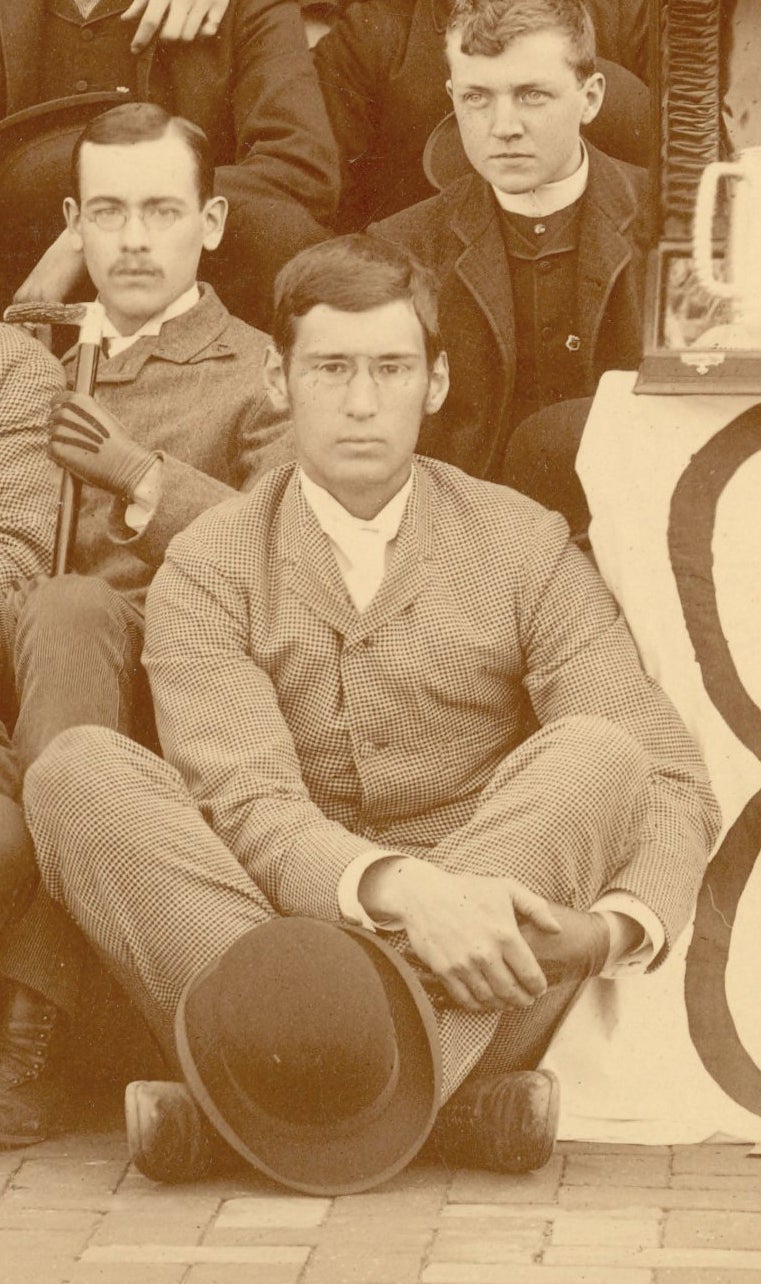George Brinton (April 11, 1868- Jan 24, 1890), Class of 1888, first entered the University of Pennsylvania in 1883 as a member of the Class of 1887. He was the son of John Hill Brinton, A.B. 1850, A.M. 1853, and LL.D. (hon.) 1901, and Sarah Ward.
During his college years Brinton was a member of the Philomathean Society, the Phi Kappa Sigma fraternity, and the University Gun Club.
Tall and muscular, Brinton had a remarkable athletic record at Penn. During his freshman year, he became the anchor for the class tug-of-war team. In his sophomore year Brinton expanded his athletic activities. During the fall sports season, he won the 100-yard dash (11¾ seconds), 220-yard dash (263⁄5 seconds), and the hammer throw (58 feet 6 inches). In the spring sports season, he won the 100-yard dash (10¼ seconds) and throwing the hammer (73 feet 7 inches). Also at the collegiate level, he was a member of Penn’s tug-of-war team. At the class level, he was a member of the Class of 1887 tennis club and football team.
When Brinton needed to repeat his sophomore year, he became a member of the Class of 1888. During his second sophomore year, he won the running broad jump (20 feet), the 100-yard dash (10½ seconds), running broad jump (19 feet 1 inch) and the hammer throw (80 feet 2½ inches — a new college record). During this year he was a member of the Class of 1888 football team and tennis club. And the following year, his junior year, he served on his class football team and racket club.
Brinton also had a number of intercollegiate wins to his credit. On 22 May 1886, during a state intercollegiate sports event, he won the 100-yard dash, running broad jump and throwing the hammer. Similarly, in the Intercollegiate Athletic Association contest of Pennsylvania held on 21 May 1887, he won the hammer throw (95 feet 3 inches) and running broad jump (19 feet 6 ½ inches), setting a new college record for Penn. In the Intercollegiate Athletic meet on 28 May 1887, he again won the hammer throw (95 feet 5½ inches) setting another college record. In the state intercollegiate sports event held on 19 May 1888, he won the hammer throw (100 feet 9½ inches), breaking his previous intercollegiate record.
Apart from his athletic accomplishments, Brinton also demonstrated leadership. He was the director of the Athletic Association during his sophomore year of 1885-1886 and also the director of the F.B. Association. He was one of Penn’s delegates to the Convention to form the Intercollegiate Athletic Association of Pennsylvania, and a member of the Committee of State Intercollegiate Games.
After he left the University of Pennsylvania, Brinton obtained a position in the Bethlehem Iron Works at Bethlehem, Pennsylvania. While working there he contracted pneumonia and died at the early age of twenty-two.
Brinton’s athletic physique served as a model for the both the scientific work of Eadweard Muybridge and the art of R. Tait McKenzie, both of whom also had ties to the University of Pennsylvania. As a Penn undergraduate, Brinton served as one of the athlete models for Eadweard Muybridge’s landmark study, Animal Locomotion. Muybridge conducted most of the work for this project on the University of Pennsylvania campus and called on many of the University’s most prominent athletes from these years to serve as subjects. Brinton appears throwing a hammer (plate 30) and heaving a 20-pound rock (plates 315 and 316).
Twenty-nine years after George Brinton’s death, his brother Jasper Yeates Brinton, A.B. 1898, LL.B. 1901, commissioned a sculpture in memory of this brilliant athlete by R. Tait McKenzie, physician, physical therapist, sculptor and also Penn’s first professor of physical education. McKenzie worked from photographs of Brinton, probably those taken by Muybridge for Animal Locomotion. The result was the “Flying Sphere,” a bronze sculpture ¼ life size. The sculpture met with wide acclaim when it was exhibited in New York, Boston, London, and Paris, and the limited edition sold out at the 1920 London Exhibition. The University of Pennsylvania art collection includes one sculpture from the limited edition; this “Flying Sphere” is displayed on campus at the Inn at Penn.



